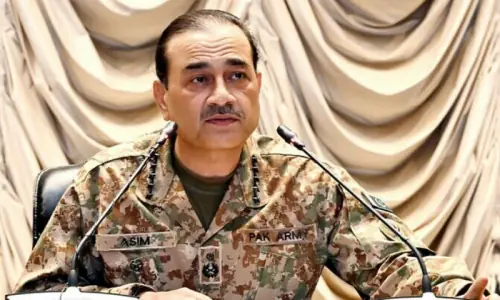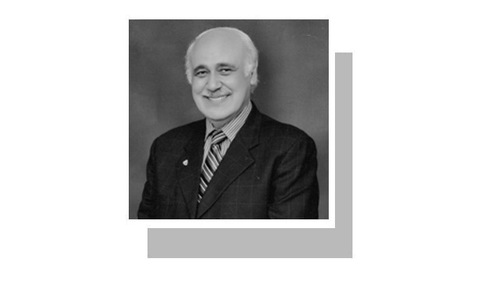
The plethora of laws used to chastise, tame and punish newspapers and journalists during the 70 years of independence suggests that they have all along been considered dangerous institutions and individuals.
That may also be the reason why Pakistan ranks high among the countries considered dangerous for media persons.
What follows is not a complete list of actions taken to punish the Press and journalists, but a selection of such actions is used to identify the means (laws, etc.):
During 1947-58, the Public Safety Act and the Security Act were used to arrest editors/publishers/printers, to punish them or force closure of their publications, or the press laws were invoked to strangulate newspapers by cancelling their declarations. The cases representative of these trends are: The arrest of Faiz Ahmad Faiz and Amir Husain Shah, editor and publisher of Imroze, in May 1948 under the Safety Act for publishing a story that was said to have defamed a DSP, and banning of Al-Wahid (Sukkur) for six months and its editor’s arrest. The Safety Act was used to guillotine daily Sarhad (Peshawar) by arresting its editor and cancelling its declaration. In 1949, the Civil & Military Gazette was closed down for six months for publishing a report about a possible division of Kashmir.
The extent to which a government could go to destroy a newspaper was revealed in the Nawa-i-Waqt case of 1951. First the printer’s declaration was cancelled, followed by the cancellation of the publisher’s declaration. Subsequently, its name was allotted to someone else and an attempt to appear under a different name (Al-Jehad) was foiled. The high court ended the ignoble charade after several months.
Daily Inquilab was forced to close down by denying it advertisements and newsprint quota. The Safety Act was used to kill Safina (Lahore) and Mr. Durrani, editor of Istiqlal (Quetta), was arrested under the Frontier Crimes Regulations (FCR). The journalists detained for trade union activities included Ahmad Ali Khan, Zaheer Babar, Hamid Hashmi, Mumtaz Husain and Ghayurul Islam.
The Ayub regime (1958-69) imprisoned editors of Imroze, Lail-o-Nahar and The Pakistan Times, Ahmad Nadeem Qasmi, Sibte Hasan and Faiz Ahmd Faiz, soon after Martial Law was proclaimed. In April 1959 the regime seized the Progressive Papers Ltd, the publishers of these publications, and escaped judicial censure by amending the Security Act.
The regime combined the existing Press laws, the Press and Registration of Books of 1867 and the Press (Emergency Powers) Act, into harsher laws under the banner of the Press and Publication Ordinances of 1960 and 1963.
The victims of Martial Law regulations included editors Mohammad Hasan Nizami (Tanzeem) and Waliullah Ahad (Kainat). The Defence of Pakistan Rules (DPR) were used to imprison Shorish Kashmiri and ban his weekly Chattan in 1966 and 1967. Salamat Ali of The Pakistan Times was hauled up under the Official Secrets Act.
The Yahya regime (1969-71) used Martial Law Regulations (MLRs) to imprison Najibullah and Shams Ghani of Pakistan Observer and Abdullah Malik of Azad.
The Bhutto government (1971-77) imprisoned Husain Naqi and Muzaffar Qadir (weekly Punjab Punch), Altaf Husain Qureshi and Ejaz Husain Qureshi (Urdu Digest), and Mujibur Rahman Shami (Zindagi), and the military court also barred them from ever becoming editors, publishers or printers.
DPR victims included Altaf Gauhar, editor of Dawn, daily Sun Karachi (declaration cancelled), Salahuddin, and Qasim Bughio (Jasarat), and daily Elan (banned) and its editor M. Akhtar (detained).
Gen. Ziaul Haq went after the Press and journalists with a vengeance. More than a hundred journalists and activists were sentenced to prison terms by military courts and four journalists – Khawar Naeem Hashmi, Nasir Zaidi, Iqbal Jafri and Masudullah Khan – were awarded 10 lashes each. The first three were whipped straightaway while Masudallah was spared because of infirmity. SGM Badruddin, Zaheer Kashmiri and Jamilur Rahman, all of Musawat, were sentenced to prison terms under MLR 33; others arrested under the same MLR included Bashir Rana and Iftikhar Husain of Sadaqat and Ayaz Amir of Muslim.
Mazhar Ali Khan and Husain Naqi of Viewpoint and Mahmud Sham of Mayar were booked under the Official Secrets Act. In October 1979, Gen Zia closed down half-a-dozen newspapers and imposed pre-censorship on all publications that remained in force in some cases until 1983. In 1981 almost the entire staff of Viewpoint and Al-Fatah was detained.
After the Zia regime in 1988, the governments of Benazir Bhutto and Nawaz Sharif in the centre and of Jam Sadiq Ali in Sindh continued using Press & Publication Ordinance (PPO) and Maintenance of Public Order (MPO) Ordinance to control the Press. A case under the Anti-Terrorism Act was registered against Maliha Lodhi, Shakilur Rahman and Saeed Ahmad of The News. Five editors of Karachi eveningers were booked under section 505 of PPC (libel), and 10-year imprisonment was awarded to Sailab Mehsud in South Waziristan under the FCR.
From the mid-1980s till 1999 the greater threat to the Press and journalists came from political factions and non-state actors who attacked journalists, prevented the circulation of newspapers, burnt houses and killed quite a few journalists.
During the last about 15 years the relatively less violent means of dealing with the Press and journalists have been replaced with enforced disappearance and killing of journalists. The unofficial figure of journalists killed since 2000 exceeds 140 while the Committee to Protect Journalists has confirmed the killing of 60 journalists in Pakistan from December 4, 1994, to February 12, 2017.
The writer is a senior political analyst and human rights activist.
This story is part of a series of 16 special reports under the banner of '70 years of Pakistan and Dawn’. Read the report here.


































